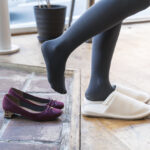Leave dirt at the door: Evidence makes case for shoe-free homes
 (NaturalHealth365) Do you ask guests to remove their shoes upon entering your home? If so, you might be in the minority. Unlike other cultures, Americans often allow guests to keep their shoes on when visiting.
(NaturalHealth365) Do you ask guests to remove their shoes upon entering your home? If so, you might be in the minority. Unlike other cultures, Americans often allow guests to keep their shoes on when visiting.
However, the findings of a new study reveal donning footwear beyond socks in an indoor setting spreads harmful pathogens to people and animals.
Why removing shoes indoors is essential for a healthier home
The study above highlights the risks of bringing harmful pathogens indoors through footwear. Shoes, whether sneakers, boots, or sandals, track allergens, pathogens, and other harmful particles onto indoor surfaces like carpets, wood floors, and concrete.
While the study focused on healthcare settings, its implications extend to homes, schools, and other indoor spaces. Despite the well-known presence of MRSA and other pathogens in high-traffic areas, the connection between these particles and clinical infection remains unclear. By the way, MRSA, a superbug, poses a serious risk of infection.
Contrary to popular belief, floors and shoe soles are not considered high-touch surfaces and are often overlooked during cleaning routines. However, the study reviewed literature revealing that footwear can spread pathogens capable of infecting humans and pets.
The comprehensive study examined 418 articles, with 18 documenting the recovery of viral pathogens and harmful bacteria from both footwear and floors. Alongside MRSA, hospital floors harbor pathogens like Clostridium difficile and E. coli. These bacteria can cause serious health issues such as colitis and, certainly, an unwanted burden on the immune system.
Everyday footwear serves as a vector for transmitting these harmful pathogens, potentially leading to hospitalization or even premature death. Unfortunately, the study did not propose an effective method for decontaminating shoe soles.
Tips to protect yourself and keep your home healthy and clean
Previous studies revealed that 15% of airborne bacteria stemmed from the redistribution of harmful bacteria into the air when walking. It was also determined that merely walking on contaminated surfaces was more likely to lead to the airborne dispersal of pathogens than sweeping or mopping. Recognize the fact that walking through the house with sneakers on is likely to transmit pathogens that serve as vectors for infectious diseases and act accordingly.
Request that everyone who enters your home remove their sneakers and other footwear to prevent the transmission of pathogens and other harmful particles. If necessary, tape a ”No Shoes” sign by the door to remind yourself, your family, friends, and other guests to remove their footwear after entering the house.
If you don’t clean your sneakers at least once every few weeks, now is the time to start. Spray down those sneakers and boots and leave them in the sun to dry. If you have a mudroom or other safe space outside the home, leave your footwear there. Even taking a couple of steps inside the home while wearing pathogen-laden sneakers increases the risk of spreading harmful germs and other harmful unseen particles throughout your living space.
Sources for this article include:



